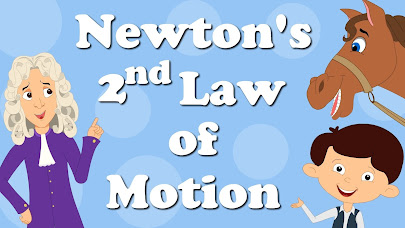FORCE AND LAWS OF MOTION, Class IX, Part 3
In order to understand Newton’s second law of motion, we should first know the meaning of the term momentum of a moving body (or moving object).
If we throw two cricket balls of the same
mass at different speeds or velocities, it will be found that more force is required
to stop that cricket ball which is moving with higher velocity and less force
is required to stop that cricket ball which is moving with higher velocity and
less force is required to stop the cricket ball moving with lower velocity. So
conclude that the force required to stop a moving body is also directly proportional
to its velocity. Thus the quantity of motion in a body depends on the mass and
velocity of the body. This given us another term knows as “momentum” the
momentum of a body is defined as the product of its mass and velocity.
Thus, Momentum = Mass x velocity.
Or P = m x v
Where P = momentum
M = mass of the body
and v = velocity (or speed) of the body
It is clear that if a body is at rest, its velocity is zero and hence its momentum is also zero. Thus the total momentum of the gun and bullet before firing is zero because their velocity is zero.
Momentum is a vector quantity and takes place
in the direction of velocity. We have just seen that momentum is equal to the
product of mass and velocity. Now mass is measured in kilograms (kg) and velocity
is measured in meters per second (m/s) so the SI unit of momentum is kilogram meters
per second which is written as kg m/s.
Every moving body possesses momentum. Since momentum depends on the mass and velocity of a body so a body will have a large momentum.
(a) If its mass is large
(b) If
its velocity (speed) is large
(c) If both its mass and velocity (speed) are
large.
For example
1. A karate player can break a pile of tiles
or a slap of ice with a single blow of his hand. This is because a karate
player strikes the pile of tiles or the slab of ice with his hand very, very
fast.
2. Though a cricket ball is not very heavy
but when it is thrown with a high speed (or high velocity) it acquires a very
large momentum and sometimes hurts the batsman.
3. A car or bus may not be running at a high
speed ( or high velocity) but because of its high mass, it has a very high
momentum which may hunt the person coming in its way.
From above examples we conclude that the combined effect of mass and velocity of a body is called momentum.
When two bodies a heavy one and a light one,
are acted upon by the same force for the same time the light body attains a
higher velocity or higher speed than the heavy one. But the momentum gained by
both the bodies is the same. The link between force and momentum is expresses
in Newton’s second law of motion.
According to Newton’s second law of motion
The rate of change of momentum of a body is directly proportional to the applied force and takes place in the direction in which the force acts. The rate of change of momentum of a body can be obtained by dividing the change in momentum by time taken for change.
For example let us consider a body of mass m having an initial velocity u. The initial momentum of this body will be mu. Suppose a force F acts on this body for time t and causes the final velocity to become v. The final momentum of this body will be mv. Now the change in momentum of this body is mv – mu and the time taken for this change is t.
So according to Newton’s second law of motion
Thus, Newton’s second law of motion gives us a relationship between
‘force’ and acceleration. When a force acts on a body, it produces acceleration
in the body.
The acceleration produced may be positive or negative. Newton’s
second law of motion also gives us a method of measuring the force in terms of
mass and acceleration. This is another definition of Newton’s law of motion.
The acceleration
produced in a body is directly proportional to the force acting on it and
inversely proportional to the mass of the body.The acceleration produced is inversely proportional to the mass of
body therefore if the mass of a body is doubled its acceleration will be
halved. If the acceleration produced is inversely proportional to the mass of
the body it means that it will be easier to move light bodies having less mass
than having bodies having large mass.
The SI unit of force is Newton which is denoted by N.
A Newton is that force which when acting on a body of mass 1 kg produces
an acceleration of 1 m/s2 in it.












Comments
Post a Comment
please do not enter any spam link in the comment box